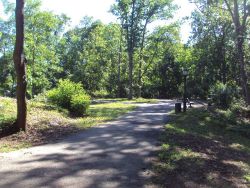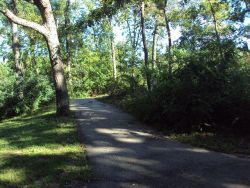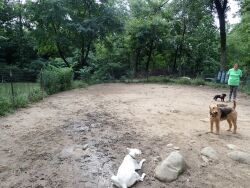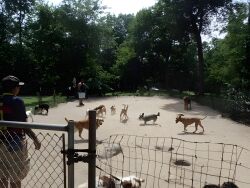Hackett Park
Hackett Park
Bound by West 254th Street, Riverdale Avenue, and the Henry Hudson Parkway, this park honors the achievements of educator Dr. Frank S. Hackett (1878-1952). Hackett was born in Albany, New York, the son of Bartholomew, a draftsman, and Elizabeth Clark, a dressmaker. He attended Trinity High School and was admitted to Columbia University. Following graduation, Hackett remained at his alma mater, becoming an English instructor. After a brief period working for a publisher, he served as Assistant Headmaster of the Berkeley School, located on East 43rd Street, between 1905 and 1907. In 1907, Hackett founded the Bronx-based Riverdale Country School with his first wife, Francis Dean Allen. (Together, the Hacketts had six children: Allen, Stephen, Daniel, Frederick, Robert, and Elizabeth.) Located near present-day Riverdale Park, the private school opened with a budget of $500, four teachers, and twelve male students. The school was founded on Dr. Hackett’s innovative “country day school” concept, in which students received scholarly, intimate teaching in locales with abundant recreation space. In 1935, Hackett founded a female campus west of the male school. In 1972, Riverdale Country School became fully coeducational with the original campus serving as the secondary school and the female campus serving as an elementary school. In the 2000-2001 academic year, Riverdale Country School had a total enrollment of 1,045 students.
In 1912, the couple founded Camp Riverdale, located in the Adirondack Mountains, to provide summer recreation for their students. In 1926, Hackett was elected president of the Schoolmasters Association of the United States. He also participated in various educational organizations throughout his life. In the 1930s, Hackett served as the vice president of the New York City Tuberculosis and Health Association. In 1937, his wife Francis died. One year later, he formed the Guild of Independent Schools of the City of New York. In 1939, Frank Hackett married Dr. Walburga Reichenberg. Three years later, Hackett published a book entitled The Torch of Life, which was a summary of his chapel talks at Riverdale Country School. In 1949, Hackett served as a delegate to the United Nations Educational, Scientific, and Cultural Organization (UNESCO) meetings. At the time of his death, Frank Hackett had received an MA from Williams College and an honorary Doctorate of Literature from Columbia University.
In January 1935, the City of New York acquired this property by condemnation. Included in the acquisition were the lands that would eventually become the Henry Hudson Parkway. Two years later, in September, Parks assumed jurisdiction over the Hackett Park property. The following month, Parks Commissioner and Chairman of the Triborough Bridge and Tunnel Authority Robert Moses (1888-1981) completed the Henry Hudson Parkway. In 1955, the City Council named the property Frank S. Hackett Park. However, the park was not dedicated until May 1956. Today, this hilly park features winding, lighted paths that traverse lush vegetation. The park’s trees species include honey locust, sweet gum, red maple, oak, and hickory. The center of the park features both a dog run and plaque in honor of the property’s namesake.
Check out your park's Vital Signs
Clean & Safe
Green & Resilient
Empowered & Engaged Users
Share your feedback or learn more about how this park is part of a
Vital Park System










